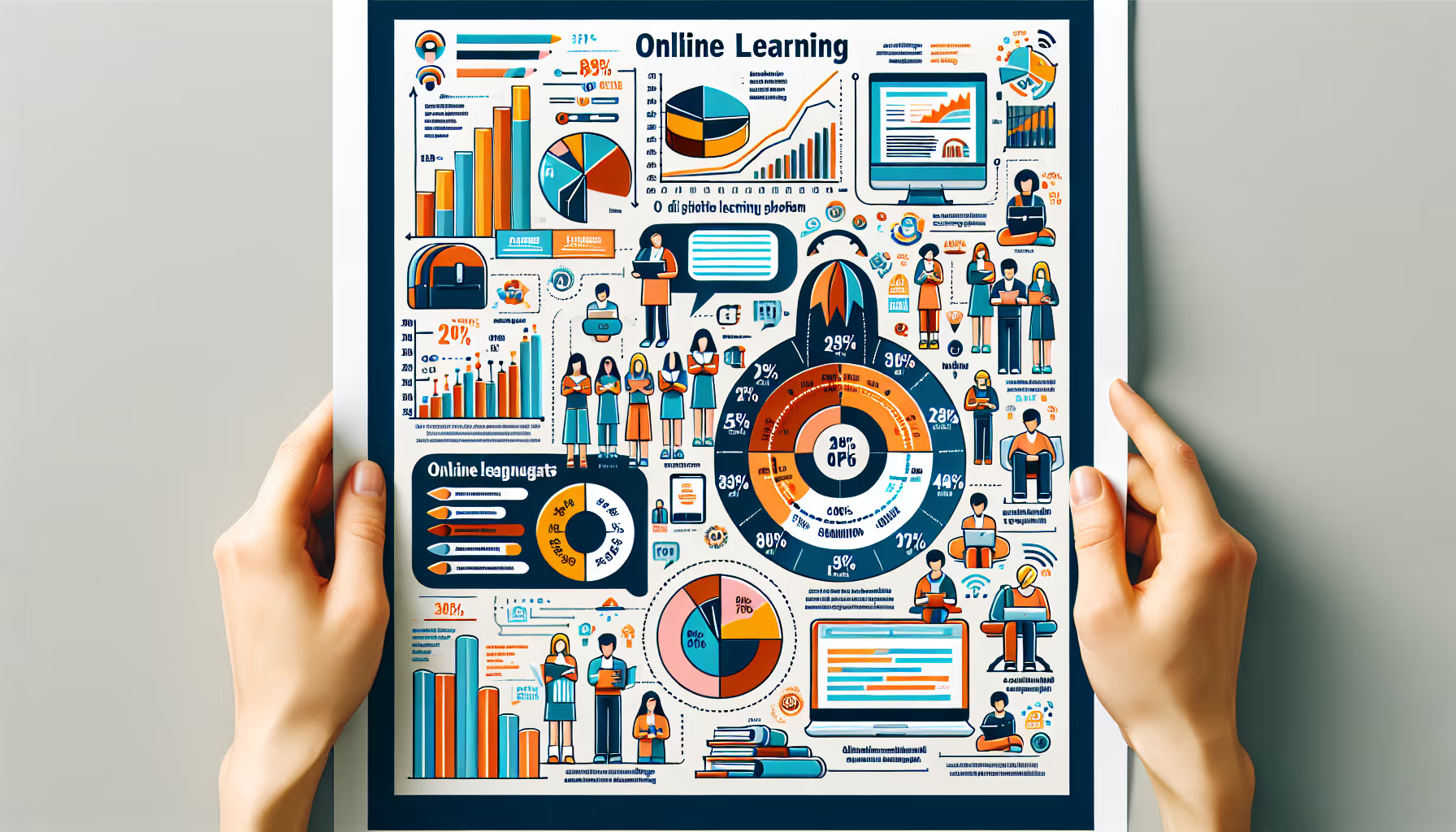Exploring E-Learning/Online Learning Statistics

Online Learning Statistics Overview
As online learning continues to gain prominence, it's important to delve into the statistics and understand various aspects of this educational approach. In this section, we will explore student preferences for learning settings, the impact of socioeconomic factors on online learning, and concerns and satisfaction with remote learning.
Here are some key statistics and trends that highlight the current state of online learning:

- Here are some key statistics and trends that highlight the current state of online learning:
- Enrollment in online courses is increasing rapidly. According to the National Center for Education Statistics, the number of students enrolled in at least one online course increased from 1.6 million in 2002 to 7.3 million in 2019.
- More institutions are offering online programs. In 2019, 70.7% of degree-granting postsecondary institutions offered distance education courses, up from 56.3% in 2002.
- Online learning is becoming more mainstream. A 2018 survey by the Babson Survey Research Group found that 33.1% of all higher education students in the United States were taking at least one online course.
- Flexibility and convenience. Online learning allows students to access course materials and complete assignments on their own schedule, making it easier to balance education with work and family obligations.
- Cost-effectiveness. Online courses often have lower tuition costs compared to traditional on-campus programs. Students also save money on transportation, housing, and textbooks.
- Increased access to education. Online learning makes education more accessible to students who live in remote areas, have mobility issues, or have other barriers to attending traditional classes.
- Technological issues. Students and instructors may face technical difficulties, such as internet connectivity problems or issues with learning management systems.
- Lack of face-to-face interaction. Online learning can feel isolating for some students who prefer in-person interaction with instructors and classmates.
- Self-motivation and time management. Online learning requires a high level of self-discipline and time management skills, as students are responsible for keeping up with course material and deadlines on their own.
Student Preferences for Learning Settings
A survey conducted by Healthline revealed interesting insights into student preferences for learning settings. According to the survey, 65% of students preferred in-person instruction, while 18% preferred a hybrid model combining in-person and online learning. Only 9% of students reported a preference for remote learning.
However, it's important to note that preferences varied significantly based on factors such as race, socioeconomic status, and parental involvement. The survey found that students from different backgrounds may have different preferences when it comes to learning settings. Understanding these preferences can help educators and policymakers tailor educational approaches to meet the needs of all students.
Impact of Socioeconomic Factors on Online Learning
Socioeconomic factors play a significant role in online learning. The same Healthline survey highlighted that Hispanic teens were more likely than Black or white teens to report inadequate internet access. Additionally, 43% of teens from households earning less than $30,000 faced challenges in completing homework due to a lack of reliable computer or internet access.
These findings shed light on the disparities that exist in access to technology and internet connectivity among students from different socioeconomic backgrounds. It is essential for policymakers and educational institutions to address these disparities and ensure that all students have equal opportunities to engage in online learning.
Concerns and Satisfaction with Remote Learning
The transition to remote learning during the pandemic brought about various concerns and levels of satisfaction among students and parents. Approximately 33% of students were not satisfied with their school's approach to remote learning, according to the same Healthline survey. However, it's worth noting that most students believed the disruption caused by the pandemic was handled well.
Parents expressed greater concern about the negative impact of the pandemic on education compared to their children. Worries about falling behind in school were expressed by 16% of students, while parents had higher levels of concern about the effects of the pandemic on education.
These concerns and levels of satisfaction highlight the need for ongoing evaluation and improvement of remote learning approaches. By addressing these concerns and ensuring student satisfaction, educators can enhance the effectiveness of online learning and provide a positive educational experience for students.
Understanding these statistics related to online learning provides valuable insights into the preferences, challenges, and satisfaction levels of students and parents. By considering these factors, educators and policymakers can make informed decisions to enhance the effectiveness and inclusivity of online learning experiences.
Online Learning Challenges and Benefits
Online learning has become increasingly popular, offering students the flexibility and convenience to pursue education remotely. However, it also presents its own set of challenges and benefits. In this section, we will explore some of the key concerns and advantages related to online learning.
Concerns about Falling Behind in School
While most students express little to no concern about falling behind in school due to pandemic disruptions, there is a portion who worry about this issue. According to a survey, about 16% of students were extremely or very worried about falling behind [1]. Parents, on the other hand, tend to be more concerned than their children about the negative effects of the pandemic on education.
It's important to address these concerns and provide support to students to ensure they have the resources and guidance they need to succeed in online learning. This includes access to reliable technology, internet connectivity, and effective communication channels with teachers and peers.
Shifting Family Dynamics during Remote Learning
One of the challenges that emerged with the shift to remote learning is the impact it has on family dynamics. With parents and guardians juggling their own work responsibilities alongside supporting their children's education, it can be challenging to find a balance.
The transition to online learning has required parents to take on additional roles, such as becoming more involved in their child's education and providing assistance with technical issues. This shift in family dynamics can be both rewarding and challenging, as it requires effective time management, communication, and support systems within the household.
Motivation and Routine in Online Education
One of the advantages of online learning is the flexibility it offers. Students have the freedom to learn at their own pace and create a schedule that works best for them. This can be particularly beneficial for individuals who do not appreciate the structure of in-person classroom meetings [2].
However, this flexibility can also present challenges. The absence of a structured routine, including the blurring of boundaries between home and schoolwork, can make it difficult for students to maintain focus and discipline. Procrastination and distractions in the home environment can impact their learning experience [3].
To overcome these challenges, it is important for students to establish a routine and create a dedicated space for learning. Setting goals, managing time effectively, and staying motivated are essential for success in online education. Additionally, leveraging technology tools for organization and communication can help students stay on track and maintain their engagement.
While online learning has its challenges, it also provides numerous benefits such as flexibility, affordability, and self-paced learning. By addressing concerns, adapting to changing family dynamics, and fostering motivation and routine, students can make the most of their online learning experience.
Popular Online Courses and Certificates
As e-learning continues to gain popularity, a wide range of online courses and certificates are available to cater to diverse interests and career goals. In this section, we will explore some of the popular options in online learning, including free courses offered by Coursera, professional certificates in demand, and the most popular college majors.
Free Courses Offered by Coursera
Coursera, a leading platform for online learning, offers a vast collection of popular free courses that cover a wide array of subjects. These courses are fully accessible without payment and provide an excellent opportunity for individuals to enhance their knowledge and skills. Some of the popular free courses on Coursera include:

These courses cover a range of topics, including well-being, languages, programming, and more. By enrolling in these free courses, learners can access high-quality educational content from renowned institutions around the world.
Professional Certificates in Demand
In addition to individual courses, online platforms like Coursera also offer professional certificates that can boost career opportunities. These certificates provide specialized knowledge and skills in various fields. Some popular professional certificates available on Coursera include:

These professional certificates demonstrate proficiency in specific areas and can be valuable assets when seeking employment or career advancement.
Most Popular College Majors
When it comes to traditional college majors, certain fields consistently attract a significant number of students. According to data from the 2019-2020 school year, the most popular college majors in the United States were business, health, and social sciences, which collectively accounted for nearly 40 percent of the 2 million bachelor's degrees conferred in the US.
Business, in particular, emerged as the most common major, with 19.0% of degrees conferred. Graduates in this field can pursue a variety of entry-level positions such as administrative assistant, marketing coordinator, human resources assistant, sales representative, and business development associate. The median salary for business majors is $65,000.
The popularity of these majors has remained consistent since 2010, reflecting the continued demand and relevance of these fields in the job market.
Whether you're looking to explore new subjects, gain professional certifications, or pursue traditional college majors, the world of online learning offers a wealth of opportunities. With the flexibility and accessibility provided by e-learning platforms, individuals can tailor their learning experiences to meet their specific interests and career aspirations.
Growth and Trends in E-Learning
As technology continues to advance, the e-learning industry is experiencing significant growth and witnessing several emerging trends. This section explores the market size and forecast, the rise of Massive Open Online Courses (MOOCs), and technological advancements in online education.
Market Size and Forecast
The E-Learning Market has experienced substantial growth in recent years and is projected to continue its upward trajectory. In 2022, the market was valued at USD 399.3 billion, and it is anticipated to grow at a Compound Annual Growth Rate (CAGR) of 14% between 2023 and 2032. This growth is fueled by the increasing demand for immersive learning experiences and hands-on training, particularly in sectors such as healthcare.
Furthermore, Research and Markets forecasts that the online education market will reach an estimated value of $350 billion by 2025. This projection highlights the immense potential for growth in the online learning sector, as more individuals seek flexible and accessible educational opportunities.
Rise of Massive Open Online Courses (MOOCs)
Massive Open Online Courses, commonly known as MOOCs, have experienced exponential growth in recent years. From 2011 to 2021, the number of learners reached by MOOCs increased from 300,000 to a staggering 220 million. The convenience and accessibility offered by MOOCs have made them a popular choice for learners around the world.
Additionally, the circumstances of the COVID-19 pandemic in 2020 rapidly accelerated the growth of hybrid and distance-only students at traditional universities by an impressive 92 percent. This sudden shift towards online education further underscored the importance and potential of MOOCs and other online learning platforms.
Technological Advancements in Online Education
Technological Advancements play a vital role in shaping the landscape of online education. With the advent of innovative tools and platforms, the learning experience has become more interactive, engaging, and personalized. EdTech companies have been at the forefront of this transformation, leveraging technologies such as artificial intelligence, virtual reality, and augmented reality to enhance the learning process.
Moreover, the market for online education has witnessed significant consolidation around a few dominant players. Institutions like Southern New Hampshire University (SNHU), Liberty University, Western Governors University (WGU), and Grand Canyon University (GCU) have experienced an average enrollment growth of 11% from 2019 to 2020. This consolidation highlights the increasing influence and market presence of these online-degree providers.
As online education continues to evolve, it is expected that the industry will witness further advancements and innovations. Mobile learning, personalized solutions, and the integration of Virtual Reality (VR), Augmented Reality (AR), and other advanced technologies are likely to shape the future of online education. By embracing these trends, the e-learning industry can continue to provide accessible and high-quality educational opportunities to learners worldwide.
Advantages and Disadvantages of Online Learning
In the realm of education, online learning has gained significant prominence, offering both advantages and disadvantages compared to traditional in-person learning methods. Understanding these benefits and challenges is crucial for individuals considering or currently engaged in online learning.
Benefits of Online Learning
Online learning comes with several notable advantages that have contributed to its increasing popularity. These benefits include:
- Personalized Learning: Online learning platforms utilize machine learning algorithms to deliver personalized learning experiences. Learners receive tailored content and recommendations based on their individual needs and progress, allowing for a more targeted and efficient learning journey [5].
- Flexibility in Scheduling: Online classes offer self-paced learning and schedule flexibility. Students can access course materials and complete assignments at their own convenience, allowing them to balance other commitments such as work or family responsibilities [2].
- Instant Feedback and Progress Tracking: Online learning platforms provide immediate feedback on assessments and assignments, allowing learners to gauge their understanding and make necessary improvements. Real-time progress tracking enables individuals to monitor their advancement and identify areas that require further attention.
- Cost-Effectiveness: Online learning often presents a more cost-effective alternative to traditional learning methods. Without the need for physical classrooms and associated expenses, online courses can be more affordable, making education accessible to a wider audience.
Challenges Faced in Online Classes
While online learning offers numerous benefits, it also presents certain challenges that learners may encounter. These challenges include:
- Self-Motivation and Discipline: Online learning requires self-motivation and discipline to stay on track with coursework. Without the structured environment of in-person classes, students must possess the self-discipline to manage their time effectively and complete assignments without constant supervision.
- Limited Social Interaction: Online learning typically lacks face-to-face interactions with peers and instructors. This limited social interaction can make it challenging for some individuals to engage in collaborative activities, discussions, and networking opportunities.
- Technical Issues and Connectivity: Online learning heavily relies on technology and internet connectivity. Technical issues, such as internet outages or software glitches, can disrupt the learning experience and hinder progress.
Privacy and Social Interaction Concerns
Privacy and social interaction are additional concerns associated with online learning. Learners may have concerns about the privacy and security of their personal information when engaging in online courses. It is important for online learning platforms to prioritize data protection and ensure the confidentiality of user information.
Furthermore, the absence of in-person interactions in online learning can limit opportunities for socialization and networking. Some individuals may miss the social dynamics and support provided by traditional classroom settings.
As the field of online learning continues to grow, addressing these challenges and concerns becomes paramount to ensure a positive and effective learning experience for all learners. By leveraging technological advancements and incorporating innovative strategies, online education can evolve to meet the diverse needs of learners, while also addressing the disadvantages traditionally associated with this mode of learning.
(Note: The extra context provided contains general information about the rise of online learning and its potential future developments, but does not directly relate to the specific section on advantages and disadvantages of online learning.)
The Future of Online Education
As the world continues to embrace digital learning, the future of online education looks promising. Several key trends and developments are shaping the landscape of e-learning and paving the way for new possibilities.
Expansion of Online Learning Market
The online learning market has experienced substantial growth in recent years and is expected to continue expanding. According to Global Market Insights, the E-Learning Market size was valued at USD 399.3 billion in 2022, and it is projected to grow at a 14% CAGR between 2023 and 2032. Factors such as the increasing adoption of technology, improving internet infrastructure, and the demand for immersive learning experiences are driving the growth of the online education industry. The accessibility and convenience offered by online learning have made it a preferred choice for individuals seeking flexible and personalized educational opportunities.
Mobile Learning and Personalized Solutions
The accessibility of online learning through mobile platforms has revolutionized the way people access educational content. Mobile learning, also known as m-learning, allows learners to access courses and educational materials on their smartphones or tablets anytime, anywhere. This has expanded the reach of online education, especially in regions with improving internet infrastructure like the Asia Pacific, where the e-learning market dominates with revenue exceeding USD 60 billion in 2022. The utilization of big data and machine learning algorithms has also enabled personalized learning solutions. By leveraging learner data and analytics, online education platforms can provide tailored content, adaptive assessments, and personalized feedback, enhancing the overall learning experience.
Integration of VR/AR and Advanced Technologies
The future of online education may involve the integration of virtual reality (VR), augmented reality (AR), and other advanced technologies. VR and AR technologies offer immersive learning experiences, allowing learners to engage with educational content through interactive simulations and virtual environments. This integration has the potential to enhance understanding, retention, and engagement in various subject areas. Additionally, advanced machine learning algorithms can be utilized to further personalize and optimize the learning process. These algorithms can analyze learner data, identify patterns, and provide customized recommendations, contributing to a more efficient and effective learning experience.
The growth and future prospects of online education are influenced by various factors, including macroeconomic trends, technological advancements, and the increasing acceptance and reliance on online education platforms. The COVID-19 pandemic has further accelerated the growth of online education, highlighting its importance and potential to supplement or replace traditional learning methods. With its advantages such as personalized learning, flexibility, and cost-effectiveness, online education is expected to play a significant role in shaping the future of education worldwide.
References
- https://www.healthline.com/health-news/65-of-students-prefer-in-person-learning-new-survey-finds
- https://universityaffairs.ca/features/feature-article/7-missing-pieces-why-students-prefer-in-person-over-online-classes/
- https://www.coursera.org/articles/most-popular-college-majors
- https://www.forbes.com/sites/ilkerkoksal/2020/05/02/the-rise-of-online-learning/
Similar articles
Contact us today to learn more.




.jpg)

.jpg)





